|
|
Divided We Stand:
The Civil War in West
Virginia
Article by Kathleen Walls
|
While the War Between the States divided
families and pitted brother against brother
(see Hatfield
McCoy Feud) only one state is a direct result of the
conflict that tore families, a nation and a state apart. West
Virginia was born of that conflict and the labor pains were
excruciating.
Since West Virginia's process of
separating from Virginia and becoming the state of West Virginia
was a lengthy legal process culminating on June 20, 1863 when
West Virginia was officially admitted to the union. However for
the sake of wordage, I will refer to the sites that later became
West Virginia as if they were already that state throughout this
article.
Besides being the first (and only) state
created as a direct result of the War Between the States, West
Virginia was the site of many firsts. In fact, West Virginia was
the scene of many extremes, "first", "only" and
"most" are common descriptive terms when it comes to
talking of the Civil War in West Virginia.
The first attempted capture of a U.S.
Amory for the purpose of freeing slaves
began before the war was officially declared. It occurred
October 16, 1859 at Harpers Ferry when John Brown led his "army'
of abolitionists in a disastrous slave revolt at Harpers Ferry
at was to become part of West Virginia.
(See more)
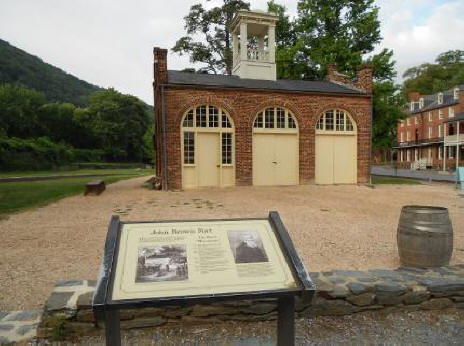 |
| John Brown's Fort at Harpers Ferry photo
credit Pat Straka |
The War Comes to West
Virginia
Officially war began at Fort Sumter in
Charleston Harbor, South Carolina on April 12, 1861. Five days
later, Confederates planned to capture the armory and arsenal
at Harpers Ferry. To
prevent it falling into southern hands, Union troops set fire to
it. April 18 was the date the first arsenal was deliberately
blown up to prevent it being captured. It would not be the last
throughout the war.
Things to see and do
in and around Harper's Ferry:
Harpers Ferry National Historical Park Check in at the
Visitors Center or Lower Town Information Center
for Ranger guided tours held
daily at 2:00p.m. The tours and living history events
will take you back as far as the town's beginnings when Robert
Harper built a ferry there. There is lots of John Brown and
Civil War history including John Brown's firehouse/fort.
Harpers Ferry, the town itself
is a step back in time. It is filled with museums and
carefully preserved to appear as it ding in the 19th century.
There are many other attractions,. a wax museum, historical
buildings and bookstores. The town offers a good choice in
restaurants Parking in the historical section is limited so try
to arrive before 9:00 a.m. Plan on spending at least a day here
to get the full experience.
Just about 15 miles northwest of Harper's
Ferry is Martinsburg, the home of Marie Isabelle Boyd, better
known as, Belle Boyd,
the famous Confederate spy. Berkeley County Historical Society
operates the home as a museum. The main ballroom is done as it
would have been in the days Belle plied her dangerous trade in
it as Union officers relaxed and danced the nights away. Little
did they realize when they dropped hints of their important
feats and secrets, the charming hostess would soon relay the
information to Thomas Stonewall Jackson to aid the Confederate
cause.
In the addition to the Greek revival
home, you will find a replica of Belle's Father, Ben Boyd's
Store. The store is a treasure chest of books and journals
related to the Civil War.
Belle Boyd House is located on East Race
Street in Martinsburg, West Virginia
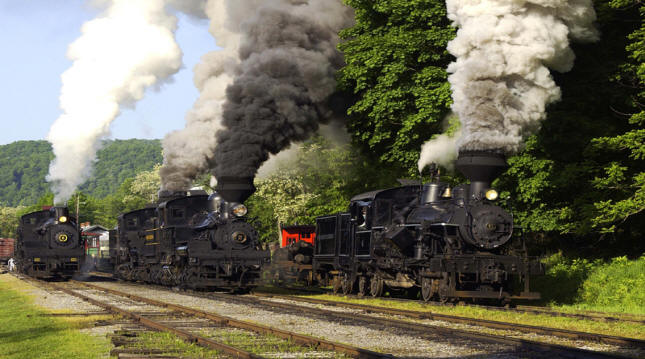 |
Cass Railroad State Park in
Pocahontas County honors the part
railroads
played in West Virginia's development. Here you can ride
the rails
Photo credit West Virginia Department of
Commerce
|
Railroads in the War
Railroads were becoming important in West
Virginia and throughout the nation as the war heated up. For the
first time, troops could be easily transported longer distances
faster. The troops arrived at the battle site rested not
exhausted from forced marches as in the past. The first Union
troops to be transported by train
during the Civil War were three companies of the 14th
Ohio Infantry on May 30th, 1861. They came to protect
Clarksburg, and the vital North Western Virginia Railroad. On
June 19th, the 8th Indiana Infantry arrived to support the Ohio
troops. Together they built the fortifications on Lowndes and
Pinnicinick Hills. The soldiers who worked on these trenches
were billeted in camps in town.
 |
| Stonewall Jackson's stature in
downtown Clarksburg |
Things to see and do
in the Clarksburg area:
Of course, the
Railroad Depot is
something you will want to see.
The earthworks and trenches that the
Union troops constructed on
Lowndes Hill, about
half a mile from the downtown courthouse square, are still in
existence. To see them visit Lowndes Hill Park. The site is
marked with a Civil Wars Trails plaque.
Clarksburg is the birthplace of Thomas
"Stonewall" Jackson. There is a stature commemorating this in
the courthouse square. A plaque makes the site of his birth
home. There is a Jackson family cemetery in Clarksburg where
many other Jacksons are Buried. Stonewall Jackson is buried in
Lexington, VA.
 |
| McWhorter Cabin at Jackson's
Mill |
About 20 miles south of Clarksburg in Weston you can visit
Jackson's Mill, the
boyhood home of Stonewall Jackson. As an orphan he and his
sister were sent there to the home of his uncle, Cummins
Jackson. An old mill is the only remaining structure from the
original Jackson homestead but there are many other authentic
18th and 19th century building that have been moved to the site.
The site is extensive offering lodging,
dining as well as demonstrations of many lost skills such as
grist milling, weaving, spinning, basket making, candle dipping,
wood working, blacksmithing, paper marbling and others.
 |
Historic covered bridge at
Philippi
Photo credit West Virginia Department of
Commerce |
The first campaign
The first campaign, The
Western Virginia
Campaign, began in May 1861. Union forces under Major
General George B. McClellan invaded West Virginia. By May 28,
McClellan had placed about 3,000 troops under the command of
Brig. Gen. Thomas A. Morris. Morris's main objective was to
protect the Baltimore and Ohio Railroad that were vital for
supply lines. Confederate Colonel Porterfield prepared to meet
the enemy by organizing a force of 775 new recruits. As the
Union forces approached, the recruits hastily retreated to
Philippi.
The
first land battle of the war was fought in Philippi
on the morning of June
3, 1861. Porterfield's new recruits were not prepared. After
only a few volleys, they fled about 45 miles south to
Huttonsville. The retreat was so hasty that one journalist
dubbed it "The Philippi Races."
 |
Reenactment of Battle of Laural
Hill
Photo credit West Virginia Department of
Commerce |
Another first occurred at Philippi, the war's first of countless
amputation. Confederate J. E. Hanger was struck in the leg by a
cannonball. He was taken prisoner and a Union doctor amputated
his mangled leg. Hanger later created an artificial limb for
himself out of barrel staves with a hinge at the "knee." He
later founded Hanger Orthopedic Group, Inc.
That company is still
one of the largest manufacturers of prosthetic in the world.
Still one more first occurred on June 3.
Colonel Benjamin Kelley was shot becoming the first Union
officer wounded by a Confederate. Proving fact even stranger
than fiction one more first occurred.
Thornbury Bailey Brown was shot in an altercation with a
Confederate soldier as he attempted to cross the bridge between
Grafton and Pruntytown. He was the first Union soldier to
be killed by a Confederate soldier.
 |
| Sign at the Carnifex Ferry
Battle Site |
Following the retreat from Philippi, Col. Porterfield was
replaced by Brig. Gen. Robert S. Garnett as commander of the
Confederate forces in West Virginia.
In June 1861,Maj. Gen. George B.
McClellan stepped in as commander of the Union forces in West
Virginia. He began moving his troops out of Clarksburg and
headed south to confront Lt.
Col. John Pegram's Confederates. The two forces clashed near
Rich Mountain on July 9. Meanwhile, Brig. Gen. Thomas A.
Morris's Union brigade had left Philippi and attacked Brig. Gen.
Robert S. Garnett's Confederates
at Laurel Hill. The next two days saw Brig. Gen. William
Rosecrans men seizing the Staunton-Parkersburg Turnpike in
Pegram's rear. About half of the Confederates surrendered and
the others escaped.
After Pegram's defeat,
Garnett had no choice but to retreat from Laurel Hill.
Union Brig. Gen. Thomas A. Morris pursued. On
July 13, Garnett was
killed by a Union volley at Corrick's Ford on the Cheat River.,
Garnett was the first general officer to be killed in the war.
From this point on the area that was to
become West Virginia was firmly in Federal hands. This cleared
the way for the area to pursue statehood as West Virginia.
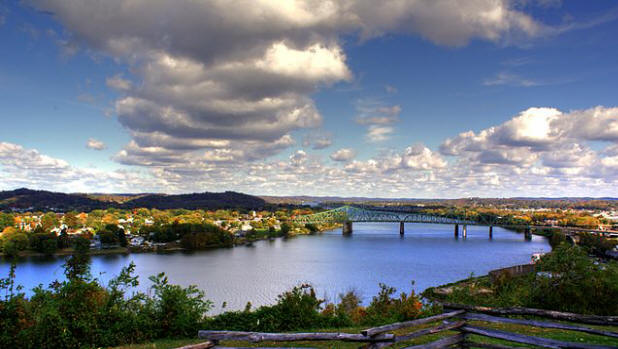 |
| Overlook for battlefield site at
Fort Boreman Park |
There were several other battles in the
Western Virginia Campaign; Kessler's Cross Lanes, Carnifex
Ferry, Cheat Mountain and Camp Allegheny. They did nothing for
the Confederate advances in the area but they did set a few
records.
In August 1861, Confederate President
Jefferson Davis met with General Robert E. Lee, his senior
military advisory. Following that conference, Lee was sent to
take command and reverse the Confederate defeats in
western Virginia. The
Sept 12-14 Battle of Cheat Summit was the first time Robert E.
Lee commanded troops in battle as a commanding general The
resulting failures in West Virginia earned the first use of his
derogatory nickname,
"Granny Lee."
Another record claimed by West Virginia
was the highest battle of the Civil War, the Battle at Camp
Alleghany on Dec 13, 1861. It occurred at 4400 ft above sea
level. Today, it is one of the best preserved battlefields of
the war.
Things to see and do
in the area of the First Campaign:
Philippi Covered bridge was built in 1852. The bridge and
surrounding area saw heavy fighting during the Battle of
Philippi and was even used as a barracks by Union troops for a
time. It was damaged by fire in 1989 but has been restored to
its 1861 condition and is one only a handful of covered bridges
used in the present federal highway system.
The Barbour County Historical Museum is
a treasure trove for a Civil War buff. It has
an extensive collection of cannons, rifles, pistols, knives
and other weapons used in the war. It also has an extensive
collection of manuscripts of the period and lots of railroad
artifacts. The downtown historical District and the Blue and
Gray Park are part of Philippi's heritage sites. Philippi holds
an annual Blue and Gray Reunion when they do a reenactment of
the Battle of Philippi on the first weekend in June.
West Virginia National Cemetery at Grafton is the burial
place of many of the soldiers killed in the first campaign
including that of Private T. Bailey Brown, the first Union
soldier killed by a Confederate.
Rich Mountain Battlefield Civil War Site
is where the two forces
clashed just after the Confederate retreat at Philippi.
The battle site, Camp Garnett, and the portion of the
original turnpike connecting the two sites is now on the
National Register of Historic Places.
Beverly Heritage Center on Court Street in downtown Beverly
has a small museum and is another place to visit for information
about this battle and the surrounding area.
Earthworks, gun positions and chimney
falls from the encampment are preserved at
Camp Allegany ,
war's highest battle site. Location: From U.S.250 near the
Virginia/WV state line, turn south at sign on County Rd. 3, turn
right at the T junction, then go 2 more miles (Road may be
closed due to snow in winter.) Open: year-round, dawn to dusk.
NR & CWDT, Disabled Access parking & interpretive area, Brochure
Available.
Carnifex Ferry Battlefield State Park
on the rim
of the Gauley River Canyon near Summersville
is the site of one of the battles that earned General Robert
E. Lee his nickname
of "Grannie Lee." Carnifex Ferry Battle will be reenacted on
September 13-14, 2014.The two-day event includes living history
demonstrations such as camp life, military drill, and a
re-enactment of the Federal assault on the center of the
Confederate line.
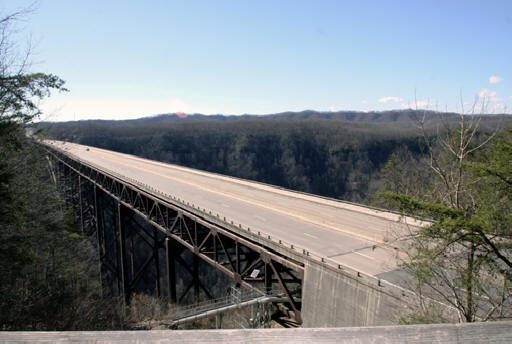 |
The bridge over the New River
Gorge is
an engineering marvel
as well as the focus for much
of Fayetteville's adventure activities |
New River Gorge Area
Another first occurred in Fayetteville
near the New River Gorge.
A historic marker at the courthouse square recognizes
Fayetteville as the site of the first use of indirect fire
during a battle.
Most of the Civil War cannons were
muzzleloaders requiring a crew of a gunner and seven
artillerymen. Add to that the wagon and horses needed to deploy
the gun and it created a big target to draw return fire. Up to
that time, cannoneers, realizing what a tempting target they
provided the enemy, attempted to lessen their danger by setting
up the cannon in a dip in the ground's surface where just the
muzzle of the cannon was exposed and the men could take cover
behind the rise of earth in front of them. If the slope is deep
enough, the recoil of the gun' firing causes it to back up even
deeper behind the earthen cover.
Until a small battle at Fayetteville,
West Virginia this was as close to indirect firing as anyone had
accomplished. At the
battle an 18-year-old
Confederate sergeant, Milton Wylie Humphreys, would change the
use of cannon firing forever. On May 16, 1863, Bryan's Battery,
Humphreys unit, under the command of Colonel John McCausland,
attacked attack the
Federal fort at Fayetteville.
What happened next was recorded by
Humphreys in his book,
Military Operations in Fayette County, West Virginia. "The
infantry went down into the woods toward the works," he wrote.
"The road to Raleigh (now Beckley, West Va.) after running in a
straight line nearly three-fourths of a mile from Fayetteville,
turns square to the left, and ascends to a small cleared plateau
with a hill on the right. On this ridge were posted Bryan's
third and fourth. The second piece (mine) was posted on the
plateau at the end of a straight opening which had been cut in
the woods and ran directly toward the Federal Fort.
"My piece opened first and was
immediately answered, and my third or fourth round cutting away
the Yankee colors, they shelled us so vigorously and accurately
with several guns that we were compelled to move to a place
nearby where we could not be seen for the timber in front of us
and the smoke behind us rising from the woods beyond the road
which were on fire."
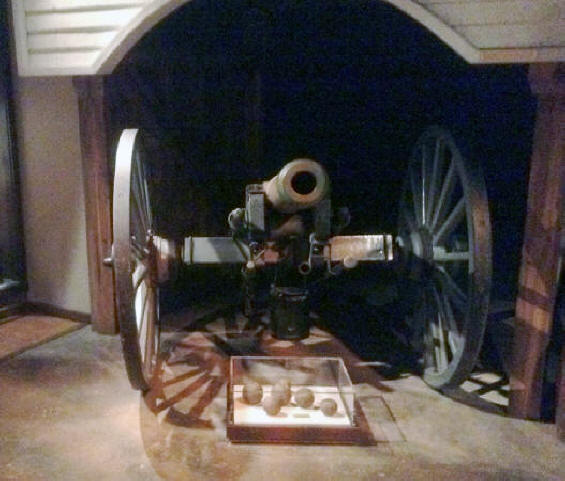 |
Civil War cannon at the West Virginia State Museum
in Charleston much
like the one used by Sergeant
Humphreys or lost by Captain Abbott |
It was the perfect place to try out his theory. Humphreys
stationed a man on a nearby hill to direct him. Since he knew
the approximate distance to the fort and was used to his
cannon's trajectory it worked. He continued his firing for the
remainder of the day until the Union
sent out a patrol to determine where the fire was
originating and then prudently withdrew. Humphreys wrote: "The
term 'indirect fire' is firing upon a point or place (A) from a
point (B) which is not visible to people at (A). It is
necessary, of course, that the trajectory or path of the
projectile should pass above the top of the 'mask' or
intervening object. At Fayetteville, May 19 and 20, 1863, the
writer used a grove as a mask, but at Winchester, Va., Sept. 19,
1864, he successfully used a low hill. I claim no credit for the
'invention'; the thing is so obvious. In fact, if I invented it,
I did not do it at Fayetteville, but in my day-dreams when I was
about 8 years old."
Another unusual incident occurred near
the New River Gorge in September of 1862. Captain Joel Abbott
and a small group of Confederate soldiers set out to destroy a
bridge across the Gauley River in West Virginia. They traveled
along the cliffs of Cotton Hill, just off the banks of the
Gauley River. The Confederates succeeded in destroying the
bridge but in the heat of battle they mislaid something that
has not ever been found.
One can only imagine trying to explain
that to a commanding officer.
Abbott later stated, "trying to get the gun back and
finding it a difficult job, we hid it in a deep ravine, and it
is there yet."
If you are ever exploring in the depths
of the New River Gorge and come across a old cannon, it may be
the very one Captain Abbott mislaid. So far as I can find out,
the only cannon mislaid and never found in the course of the
war.
Things to see in Fayetteville:
New River Gorge National Park Visitors Center is the best
way to get an overall view of the New River Gorge.
But if you are more adventurous take a
Bridge Walk or visit
On Bridge Day.
If you really want to search for that
lost cannon, you will need to take a hike or horseback excursion
into the gorge. There is lots of adventure fun in the gorge.
 |
| Exhibits at Burning Spring Park
Oil and Gas Museum |
First Oil Field:
We tend to think of oil fields as modern
military targets but the first oil field to become a military
target was Burning
Springs Oil Field near Parkersburg, West Virginia. A highway
marker at the site states that the Rathbone Well was begun in
1859 and completed in May 1860. It is the oldest producing well
in the world. The well was drilled with a "Spring Pole" near the
mouth of Burning Spring Run and produced about 100 gallons per
day. Confederate General Jones fired the well and all the
storage containers destroying about 20,000 gallons of oil.
Things to see and do in Parkersburg:
A self-guided tour at
Burning Spring Park Oil
and Gas Museum tells stories of the nation's first oil and
gas field. See the world's oldest producing oil well and learn
more about the role it played in West Virginia statehood and the
Civil War.
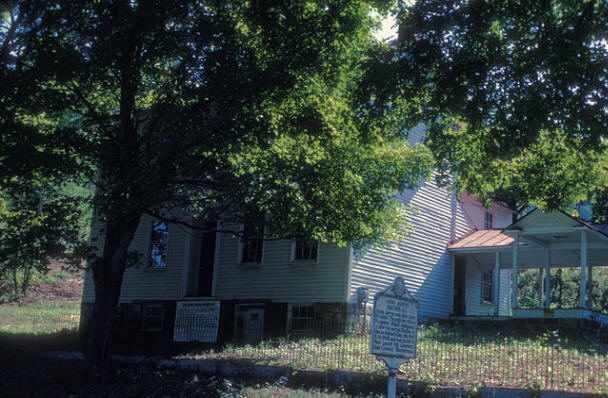 |
| Anna Jarvis home |
Fort Boreman Historical
Park, the site of a Civil War fort built by Union troops to
protect the Baltimore and Ohio Railroad terminal and important
river facilities in the valley . It was named for West
Virginia's first governor, Parkersburg citizen Arthur I.
Boreman. It is the home of Carlin's Battery D - 1st West
Virginia Light Artillery, a reenactment group that acts as
county ambassadors.
Anna Jarves Birthplace Museum was used as a field
headquarters by General McClellan in the summer of 1861 during
the Western Virginia Campaign. The museum is the home of Anna
Jarvis, the founder of Mother's Day.
One room contains information related to
McClellan's stay in the home. It is located in Grafton.
Aftermath:
West Virginia was comprised of almost as
many Confederate supporters as Union in spite of its official
stance. It was the only state having
approximately the
same number of Union (562) and Confederate (563) veterans
attending the first the Battle of Gettysburg reunion in 1913.
They were the only state to have such an equal representation,
Just one more symbol of
the state's extremely divided nature during the Civil War.
For
more info:
http://www.wvcommerce.org/travel/thingstodo/history/civilwar/sites.aspx
http://www.nps.gov/hafe/index.htm
http://www.clarksburgvisitorswv.com/MustSee.aspx
http://www.greaterparkersburg.com/browse/attraction
http://www.philippi.org/citysite/
http://visitfayettevillewv.com/
http://www.cassrailroad.com
www.newrivergorgecvb.com
www.officialbridgeday.com
|